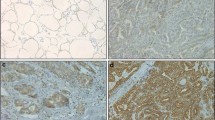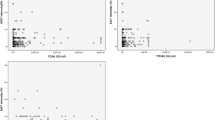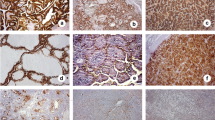Abstract
This study examined the association between hector battifora mesothelial antigen-1 (HBME-1) expression and papillary thyroid carcinoma (PTC). A total of 206 patients were enrolled in the current study including 96 PTC patients and 110 patients with benign thyroid nodules (BTN). Immunohistochemistry (Envision) were performed to assess the expression of HBME-1. Receiver operating characteristic curve (ROC) curves were applied to evaluate the diagnostic tumor node metastasis (TNM) value of HBME-1. Specimens from 96 patients with PTC and 110 patients with BTC were reviewed. HBME-1 was positively immunostained in PTC tissue, which was significantly higher than that in BTN tissues (77.1 vs. 5.77 %, P < 0.05). Immunohistochemistry also identified that HBME-1 expression did not show any statistically significant differences based on gender, age, tumor size, TNM stage, and lymph node metastasis (P > 0.05). Importantly, HBME-1 expression was correlated with infiltration levels and differential levels in PTC (both P < 0.05). HBME-1 was found to have high sensitivity (94.5 %) and specificity (77.08 %) for PTC diagnosis. Moreover, HBME-1 had a high specificity (83.33 %) at identifying the differential levels of PTC, but a low sensitivity (22.92 %). The sensitivity and specificity of HBME-1 identifying the infiltration levels of PTC were, respectively, 72.70 and 72.00 %. HBME-1 was highly expressed in PTC tissues, and HBME-1 can serve as a potential biomarker in the diagnosis of PTC.


Similar content being viewed by others
References
Dinets A, Pernemalm M, Kjellin H, Sviatoha V, Sofiadis A, Juhlin CC, et al. Differential protein expression profiles of cyst fluid from papillary thyroid carcinoma and benign thyroid lesions. PLoS One. 2015;10(5):e0126472.
Grant CS. Papillary thyroid cancer: Strategies for optimal individualized surgical management. Clin Ther. 2014;36(7):1117–26.
Takahashi M, Saenko VA, Rogounovitch TI, Kawaguchi T, Drozd VM, Takigawa-Imamura H, et al. The foxe1 locus is a major genetic determinant for radiation-related thyroid carcinoma in Chernobyl. Hum Mol Genet. 2010;19(12):2516–23.
Kim SK, Park HJ, Hong IK, Chung JH, Eun YG. A missense polymorphism (rs11466653, met326thr) of toll-like receptor 10 (tlr10) is associated with tumor size of papillary thyroid carcinoma in the Korean population. Endocrine. 2013;43(1):161–9.
Boufraqech M, Fassassi C, Kebebew E. Tlr-10 polymorphism and papillary thyroid cancer: one more snp to consider? Endocrine. 2013;43(1):10–1.
Dinets A, Hulchiy M, Sofiadis A, Ghaderi M, Hoog A, Larsson C, et al. Clinical, genetic, and immunohistochemical characterization of 70 Ukrainian adult cases with post-Chernobyl papillary thyroid carcinoma. Eur J Endocrinol. 2012;166(6):1049–60.
Owonikoko TK, Hossain MS, Bhimani C, Chen Z, Kim S, Ramalingam SS, et al. Soluble fas ligand as a biomarker of disease recurrence in differentiated thyroid cancer. Cancer. 2013;119(8):1503–11.
Schmitt AC, Cohen C, Siddiqui MT. Paired box gene 8, hbme-1, and cytokeratin 19 expression in preoperative fine-needle aspiration of papillary thyroid carcinoma: diagnostic utility. Cancer Cytopathology. 2010;118(4):196–202.
Guerra A, Marotta V, Deandrea M, Motta M, Limone PP, Caleo A, et al. Braf (v600e) associates with cytoplasmatic localization of p27kip1 and higher cytokeratin 19 expression in papillary thyroid carcinoma. Endocrine. 2013;44(1):165–71.
de Matos LL, Del Giglio AB, Matsubayashi CO, de Lima FM, Del Giglio A, da Silva Pinhal MA. Expression of ck-19, galectin-3 and hbme-1 in the differentiation of thyroid lesions: Systematic review and diagnostic meta-analysis. Diagn Pathol. 2012;7:97.
Scognamiglio T, Hyjek E, Kao J, Chen YT. Diagnostic usefulness of hbme1, galectin-3, ck19, and cited1 and evaluation of their expression in encapsulated lesions with questionable features of papillary thyroid carcinoma. Am J Clin Pathol. 2006;126(5):700–8.
de Matos PS, Ferreira AP, de Oliveira FF, Assumpcao LV, Metze K, Ward LS. Usefulness of hbme-1, cytokeratin 19 and galectin-3 immunostaining in the diagnosis of thyroid malignancy. Histopathology. 2005;47(4):391–401.
Nga ME, Lim GS, Soh CH, Kumarasinghe MP. Hbme-1 and ck19 are highly discriminatory in the cytological diagnosis of papillary thyroid carcinoma. Diagn Cytopathol. 2008;36(8):550–6.
Cui W, Sang W, Zheng S, Ma Y, Liu X, Zhang W. Usefulness of cytokeratin-19, galectin-3, and hector battifora mesothelial-1 in the diagnosis of benign and malignant thyroid nodules. Clin Lab. 2012;58(7-8):673–80.
Fadda G, Rossi ED, Raffaelli M, Pontecorvi A, Sioletic S, Morassi F, et al. Follicular thyroid neoplasms can be classified as low- and high-risk according to hbme-1 and galectin-3 expression on liquid-based fine-needle cytology. Eur J Endocrinol. 2011;165(3):447–53.
Cheung CC, Ezzat S, Freeman JL, Rosen IB, Asa SL. Immunohistochemical diagnosis of papillary thyroid carcinoma. Mod Pathol. 2001;14(4):338–42.
Mase T, Funahashi H, Koshikawa T, Imai T, Nara Y, Tanaka Y, et al. Hbme-1 immunostaining in thyroid tumors especially in follicular neoplasm. Endocr J. 2003;50(2):173–7.
Chung SY, Park ES, Park SY, Song JY, Ryu HS. Cxc motif ligand 12 as a novel diagnostic marker for papillary thyroid carcinoma. Head Neck. 2014;36(7):1005–12.
Beesley MF, McLaren KM. Cytokeratin 19 and galectin-3 immunohistochemistry in the differential diagnosis of solitary thyroid nodules. Histopathology. 2002;41(3):236–43.
Zintzaras E, Ioannidis JP. Hegesma: Genome search meta-analysis and heterogeneity testing. Bioinformatics. 2005;21(18):3672–3.
Carling T, Ocal IT, Udelsman R. Special variants of differentiated thyroid cancer: does it alter the extent of surgery versus well-differentiated thyroid cancer? World J Surg. 2007;31(5):916–23.
Faquin WC, Baloch ZW. Fine-needle aspiration of follicular patterned lesions of the thyroid: diagnosis, management, and follow-up according to national cancer institute (nci) recommendations. Diagn Cytopathol. 2010;38(10):731–9.
Ohori NP, Wolfe J, Hodak SP, LeBeau SO, Yip L, Carty SE, et al. "Colloid-rich" follicular neoplasm/suspicious for follicular neoplasm thyroid fine-needle aspiration specimens: cytologic, histologic, and molecular basis for considering an alternate view. Cancer Cytopathology. 2013;121(12):718–28.
Nasr MR, Mukhopadhyay S, Zhang S, Katzenstein AL. Immunohistochemical markers in diagnosis of papillary thyroid carcinoma: utility of hbme1 combined with ck19 immunostaining. Mod Pathol. 2006;19(12):1631–7.
Lansoy-Kuhn C, Picquenot JM, Edet-Sanson A, Mechken F, Laberge-Le Couteulx S, Cornic M, et al. Relationship between the immunohistochemistry of the primary tumour and 18f-fdg-pet/ct at recurrence in patients with well-differentiated thyroid carcinoma. Nucl Med Commun. 2013;34(4):340–6.
Barut F, Onak Kandemir N, Bektas S, Bahadir B, Keser S, Ozdamar SO. Universal markers of thyroid malignancies: Galectin-3, hbme-1, and cytokeratin-19. Endocr Pathol. 2010;21(2):80–9.
Paunovic I, Isic T, Havelka M, Tatic S, Cvejic D, Savin S. Combined immunohistochemistry for thyroid peroxidase, galectin-3, ck19 and hbme-1 in differential diagnosis of thyroid tumors. APMIS. 2012;120(5):368–79.
Wu G, Wang J, Zhou Z, Li T, Tang F. Combined staining for immunohistochemical markers in the diagnosis of papillary thyroid carcinoma: Improvement in the sensitivity or specificity? J Int Med Res. 2013;41(4):975–83.
Saleh HA, Jin B, Barnwell J, Alzohaili O. Utility of immunohistochemical markers in differentiating benign from malignant follicular-derived thyroid nodules. Diagn Pathol. 2010;5:9.
Zhu X, Sun T, Lu H, Zhou X, Lu Y, Cai X, et al. Diagnostic significance of ck19, ret, galectin-3 and hbme-1 expression for papillary thyroid carcinoma. J Clin Pathol. 2010;63(9):786–9.
Nechifor-Boila A, Borda A, Sassolas G, Hafdi-Nejjari Z, Borson-Chazot F, Lifante JC, et al. Immunohistochemical markers in the diagnosis of papillary thyroid carcinomas: The promising role of combined immunostaining using hbme-1 and cd56. Pathol Res Pract. 2013;209(9):585–92.
Casey MB, Lohse CM, Lloyd RV. Distinction between papillary thyroid hyperplasia and papillary thyroid carcinoma by immunohistochemical staining for cytokeratin 19, galectin-3, and hbme-1. Endocr Pathol. 2003;14(1):55–60.
Acknowledgments
We would like to acknowledge the reviewers for their helpful comments on this paper.
Author information
Authors and Affiliations
Corresponding author
Ethics declarations
Conflict of interest
None.
Rights and permissions
About this article
Cite this article
Chen, YJ., Zhao, RM., Zhao, Q. et al. Diagnostic significance of elevated expression of HBME-1 in papillary thyroid carcinoma. Tumor Biol. 37, 8715–8720 (2016). https://doi.org/10.1007/s13277-015-4169-5
Received:
Accepted:
Published:
Issue Date:
DOI: https://doi.org/10.1007/s13277-015-4169-5




